Essay on Addiction: Treatment Methods and the Brain Disease Model
VerifiedAdded on 2022/11/14
|7
|2313
|54
Essay
AI Summary
This essay delves into the multifaceted concept of addiction, substance abuse, and their intricate relationship with the brain and human behavior. It defines substance use disorder (SUD) as a disease impacting the brain and behavior, exploring various treatment methods, interventions, and strategies for effective management. The essay examines substances like alcohol, marijuana, and nicotine, acknowledging the multitude of contributing factors. It outlines current addiction treatment methods while critically analyzing the brain disease model, presenting counterarguments and providing a comprehensive understanding of treatment approaches, supported by scholarly literature. The discussion emphasizes the profound impact of SUD on individual health and well-being, encompassing the symptoms, diagnostic considerations, and the role of brain dysfunction. The essay further explores the vulnerability of the adolescent brain, preventive measures, and the role of the prefrontal cortex. It also discusses the biological, neurological, and genetic factors contributing to addiction. Furthermore, it highlights various treatment methods, including behavioral therapies, medications, and therapeutic communities, while addressing the negative aspects of the disease model and providing a balanced perspective on the complexities of addiction.
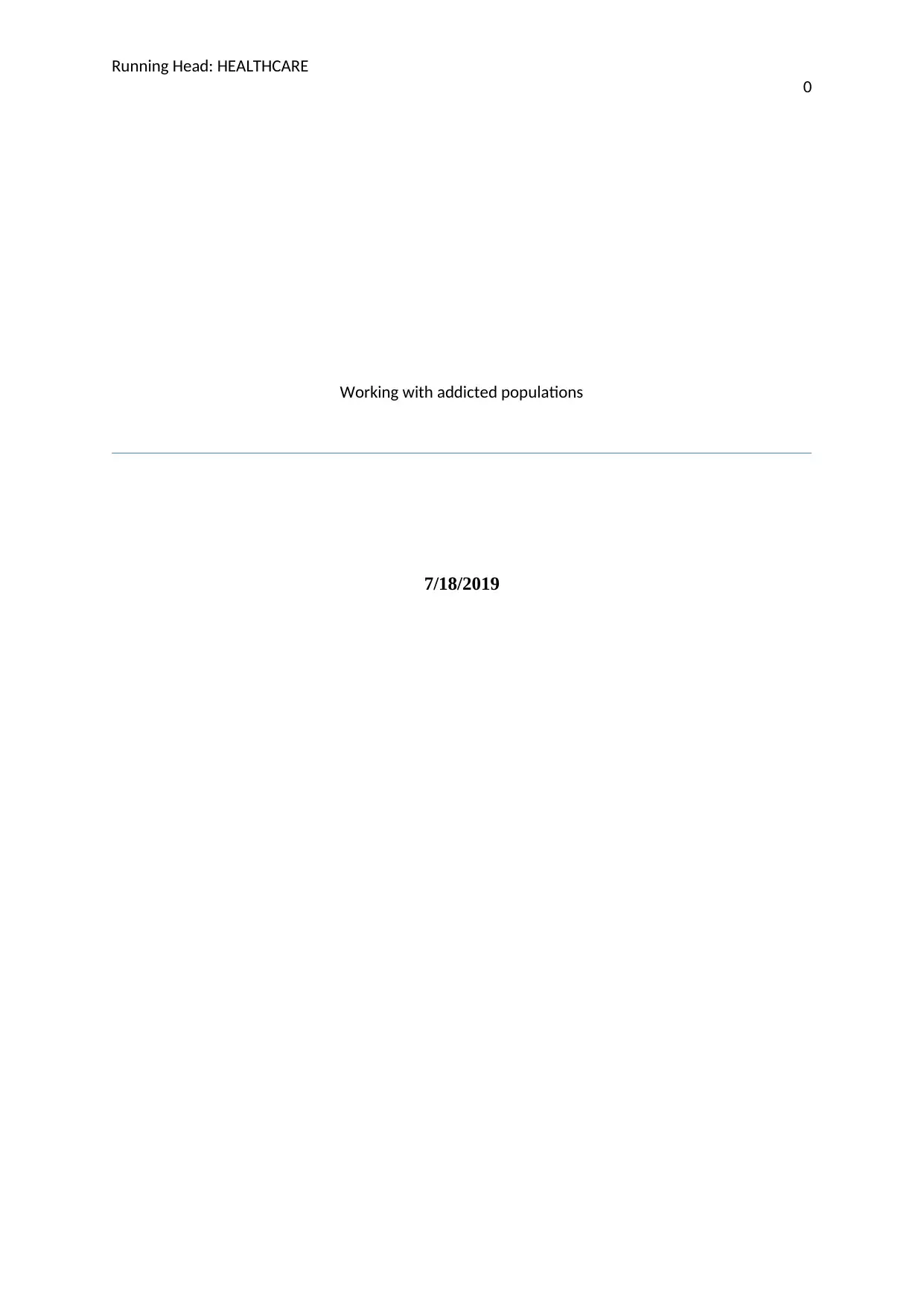
Running Head: HEALTHCARE
0
Working with addicted populations
7/18/2019
0
Working with addicted populations
7/18/2019
Paraphrase This Document
Need a fresh take? Get an instant paraphrase of this document with our AI Paraphraser
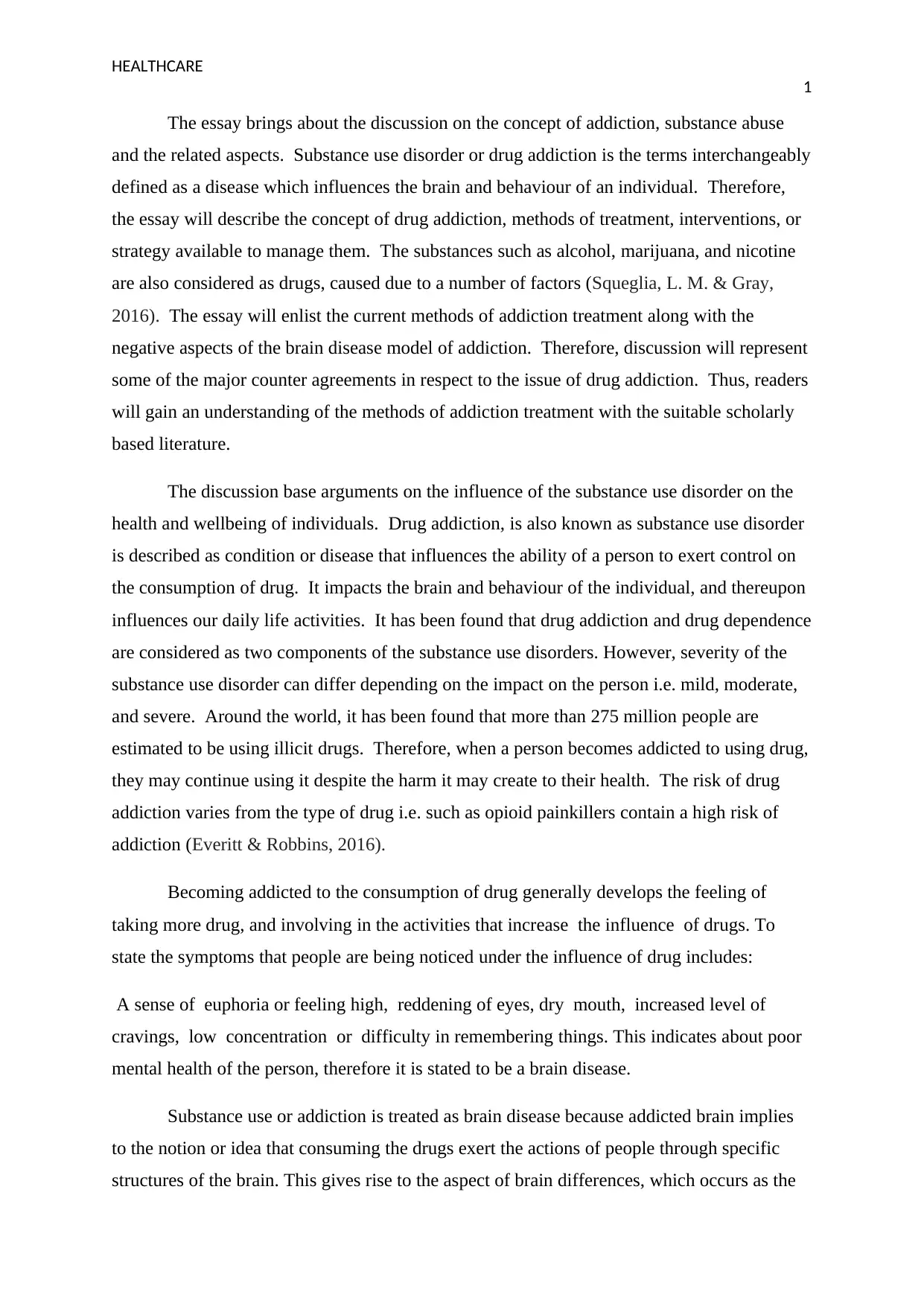
HEALTHCARE
1
The essay brings about the discussion on the concept of addiction, substance abuse
and the related aspects. Substance use disorder or drug addiction is the terms interchangeably
defined as a disease which influences the brain and behaviour of an individual. Therefore,
the essay will describe the concept of drug addiction, methods of treatment, interventions, or
strategy available to manage them. The substances such as alcohol, marijuana, and nicotine
are also considered as drugs, caused due to a number of factors (Squeglia, L. M. & Gray,
2016). The essay will enlist the current methods of addiction treatment along with the
negative aspects of the brain disease model of addiction. Therefore, discussion will represent
some of the major counter agreements in respect to the issue of drug addiction. Thus, readers
will gain an understanding of the methods of addiction treatment with the suitable scholarly
based literature.
The discussion base arguments on the influence of the substance use disorder on the
health and wellbeing of individuals. Drug addiction, is also known as substance use disorder
is described as condition or disease that influences the ability of a person to exert control on
the consumption of drug. It impacts the brain and behaviour of the individual, and thereupon
influences our daily life activities. It has been found that drug addiction and drug dependence
are considered as two components of the substance use disorders. However, severity of the
substance use disorder can differ depending on the impact on the person i.e. mild, moderate,
and severe. Around the world, it has been found that more than 275 million people are
estimated to be using illicit drugs. Therefore, when a person becomes addicted to using drug,
they may continue using it despite the harm it may create to their health. The risk of drug
addiction varies from the type of drug i.e. such as opioid painkillers contain a high risk of
addiction (Everitt & Robbins, 2016).
Becoming addicted to the consumption of drug generally develops the feeling of
taking more drug, and involving in the activities that increase the influence of drugs. To
state the symptoms that people are being noticed under the influence of drug includes:
A sense of euphoria or feeling high, reddening of eyes, dry mouth, increased level of
cravings, low concentration or difficulty in remembering things. This indicates about poor
mental health of the person, therefore it is stated to be a brain disease.
Substance use or addiction is treated as brain disease because addicted brain implies
to the notion or idea that consuming the drugs exert the actions of people through specific
structures of the brain. This gives rise to the aspect of brain differences, which occurs as the
1
The essay brings about the discussion on the concept of addiction, substance abuse
and the related aspects. Substance use disorder or drug addiction is the terms interchangeably
defined as a disease which influences the brain and behaviour of an individual. Therefore,
the essay will describe the concept of drug addiction, methods of treatment, interventions, or
strategy available to manage them. The substances such as alcohol, marijuana, and nicotine
are also considered as drugs, caused due to a number of factors (Squeglia, L. M. & Gray,
2016). The essay will enlist the current methods of addiction treatment along with the
negative aspects of the brain disease model of addiction. Therefore, discussion will represent
some of the major counter agreements in respect to the issue of drug addiction. Thus, readers
will gain an understanding of the methods of addiction treatment with the suitable scholarly
based literature.
The discussion base arguments on the influence of the substance use disorder on the
health and wellbeing of individuals. Drug addiction, is also known as substance use disorder
is described as condition or disease that influences the ability of a person to exert control on
the consumption of drug. It impacts the brain and behaviour of the individual, and thereupon
influences our daily life activities. It has been found that drug addiction and drug dependence
are considered as two components of the substance use disorders. However, severity of the
substance use disorder can differ depending on the impact on the person i.e. mild, moderate,
and severe. Around the world, it has been found that more than 275 million people are
estimated to be using illicit drugs. Therefore, when a person becomes addicted to using drug,
they may continue using it despite the harm it may create to their health. The risk of drug
addiction varies from the type of drug i.e. such as opioid painkillers contain a high risk of
addiction (Everitt & Robbins, 2016).
Becoming addicted to the consumption of drug generally develops the feeling of
taking more drug, and involving in the activities that increase the influence of drugs. To
state the symptoms that people are being noticed under the influence of drug includes:
A sense of euphoria or feeling high, reddening of eyes, dry mouth, increased level of
cravings, low concentration or difficulty in remembering things. This indicates about poor
mental health of the person, therefore it is stated to be a brain disease.
Substance use or addiction is treated as brain disease because addicted brain implies
to the notion or idea that consuming the drugs exert the actions of people through specific
structures of the brain. This gives rise to the aspect of brain differences, which occurs as the
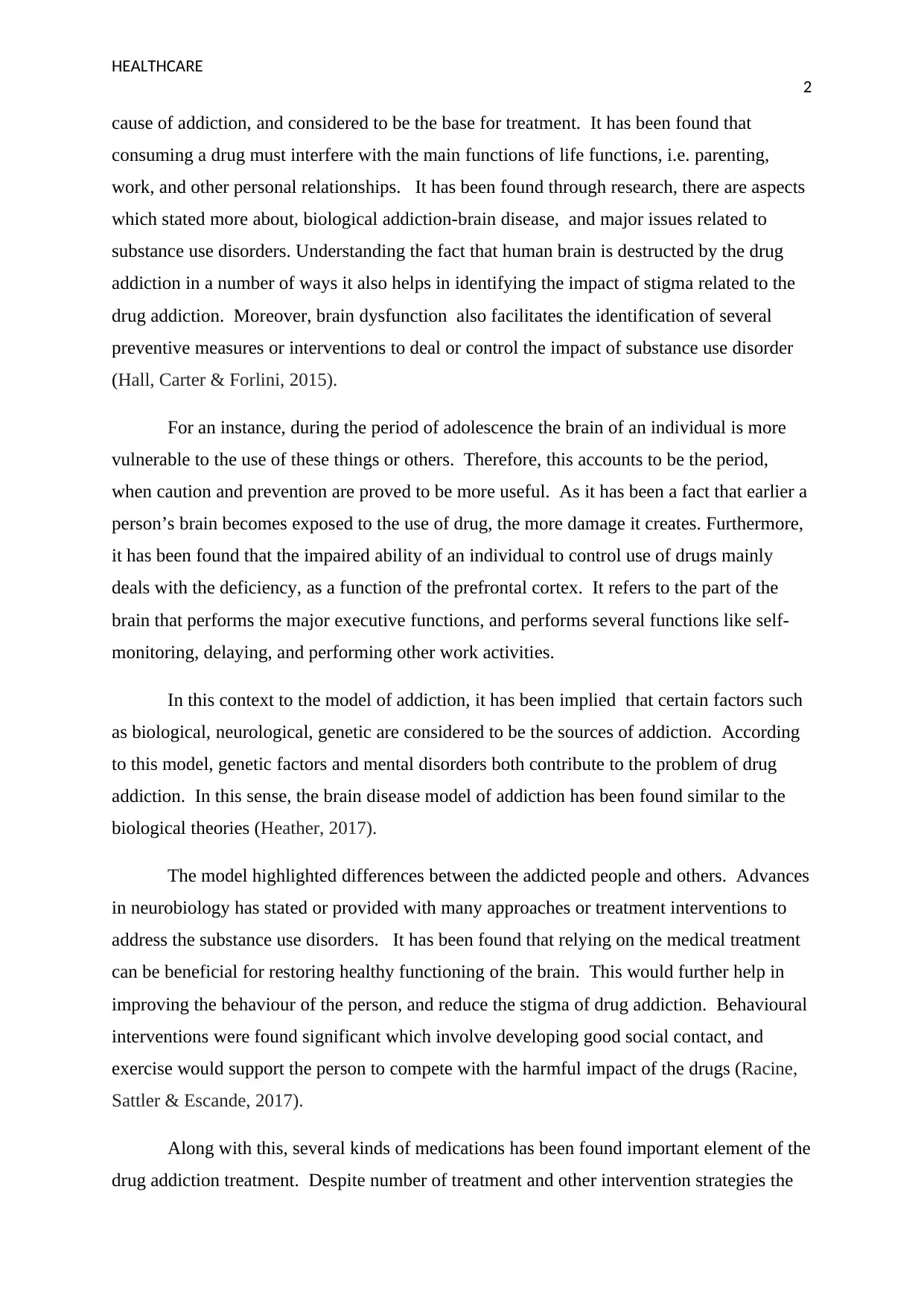
HEALTHCARE
2
cause of addiction, and considered to be the base for treatment. It has been found that
consuming a drug must interfere with the main functions of life functions, i.e. parenting,
work, and other personal relationships. It has been found through research, there are aspects
which stated more about, biological addiction-brain disease, and major issues related to
substance use disorders. Understanding the fact that human brain is destructed by the drug
addiction in a number of ways it also helps in identifying the impact of stigma related to the
drug addiction. Moreover, brain dysfunction also facilitates the identification of several
preventive measures or interventions to deal or control the impact of substance use disorder
(Hall, Carter & Forlini, 2015).
For an instance, during the period of adolescence the brain of an individual is more
vulnerable to the use of these things or others. Therefore, this accounts to be the period,
when caution and prevention are proved to be more useful. As it has been a fact that earlier a
person’s brain becomes exposed to the use of drug, the more damage it creates. Furthermore,
it has been found that the impaired ability of an individual to control use of drugs mainly
deals with the deficiency, as a function of the prefrontal cortex. It refers to the part of the
brain that performs the major executive functions, and performs several functions like self-
monitoring, delaying, and performing other work activities.
In this context to the model of addiction, it has been implied that certain factors such
as biological, neurological, genetic are considered to be the sources of addiction. According
to this model, genetic factors and mental disorders both contribute to the problem of drug
addiction. In this sense, the brain disease model of addiction has been found similar to the
biological theories (Heather, 2017).
The model highlighted differences between the addicted people and others. Advances
in neurobiology has stated or provided with many approaches or treatment interventions to
address the substance use disorders. It has been found that relying on the medical treatment
can be beneficial for restoring healthy functioning of the brain. This would further help in
improving the behaviour of the person, and reduce the stigma of drug addiction. Behavioural
interventions were found significant which involve developing good social contact, and
exercise would support the person to compete with the harmful impact of the drugs (Racine,
Sattler & Escande, 2017).
Along with this, several kinds of medications has been found important element of the
drug addiction treatment. Despite number of treatment and other intervention strategies the
2
cause of addiction, and considered to be the base for treatment. It has been found that
consuming a drug must interfere with the main functions of life functions, i.e. parenting,
work, and other personal relationships. It has been found through research, there are aspects
which stated more about, biological addiction-brain disease, and major issues related to
substance use disorders. Understanding the fact that human brain is destructed by the drug
addiction in a number of ways it also helps in identifying the impact of stigma related to the
drug addiction. Moreover, brain dysfunction also facilitates the identification of several
preventive measures or interventions to deal or control the impact of substance use disorder
(Hall, Carter & Forlini, 2015).
For an instance, during the period of adolescence the brain of an individual is more
vulnerable to the use of these things or others. Therefore, this accounts to be the period,
when caution and prevention are proved to be more useful. As it has been a fact that earlier a
person’s brain becomes exposed to the use of drug, the more damage it creates. Furthermore,
it has been found that the impaired ability of an individual to control use of drugs mainly
deals with the deficiency, as a function of the prefrontal cortex. It refers to the part of the
brain that performs the major executive functions, and performs several functions like self-
monitoring, delaying, and performing other work activities.
In this context to the model of addiction, it has been implied that certain factors such
as biological, neurological, genetic are considered to be the sources of addiction. According
to this model, genetic factors and mental disorders both contribute to the problem of drug
addiction. In this sense, the brain disease model of addiction has been found similar to the
biological theories (Heather, 2017).
The model highlighted differences between the addicted people and others. Advances
in neurobiology has stated or provided with many approaches or treatment interventions to
address the substance use disorders. It has been found that relying on the medical treatment
can be beneficial for restoring healthy functioning of the brain. This would further help in
improving the behaviour of the person, and reduce the stigma of drug addiction. Behavioural
interventions were found significant which involve developing good social contact, and
exercise would support the person to compete with the harmful impact of the drugs (Racine,
Sattler & Escande, 2017).
Along with this, several kinds of medications has been found important element of the
drug addiction treatment. Despite number of treatment and other intervention strategies the
⊘ This is a preview!⊘
Do you want full access?
Subscribe today to unlock all pages.

Trusted by 1+ million students worldwide
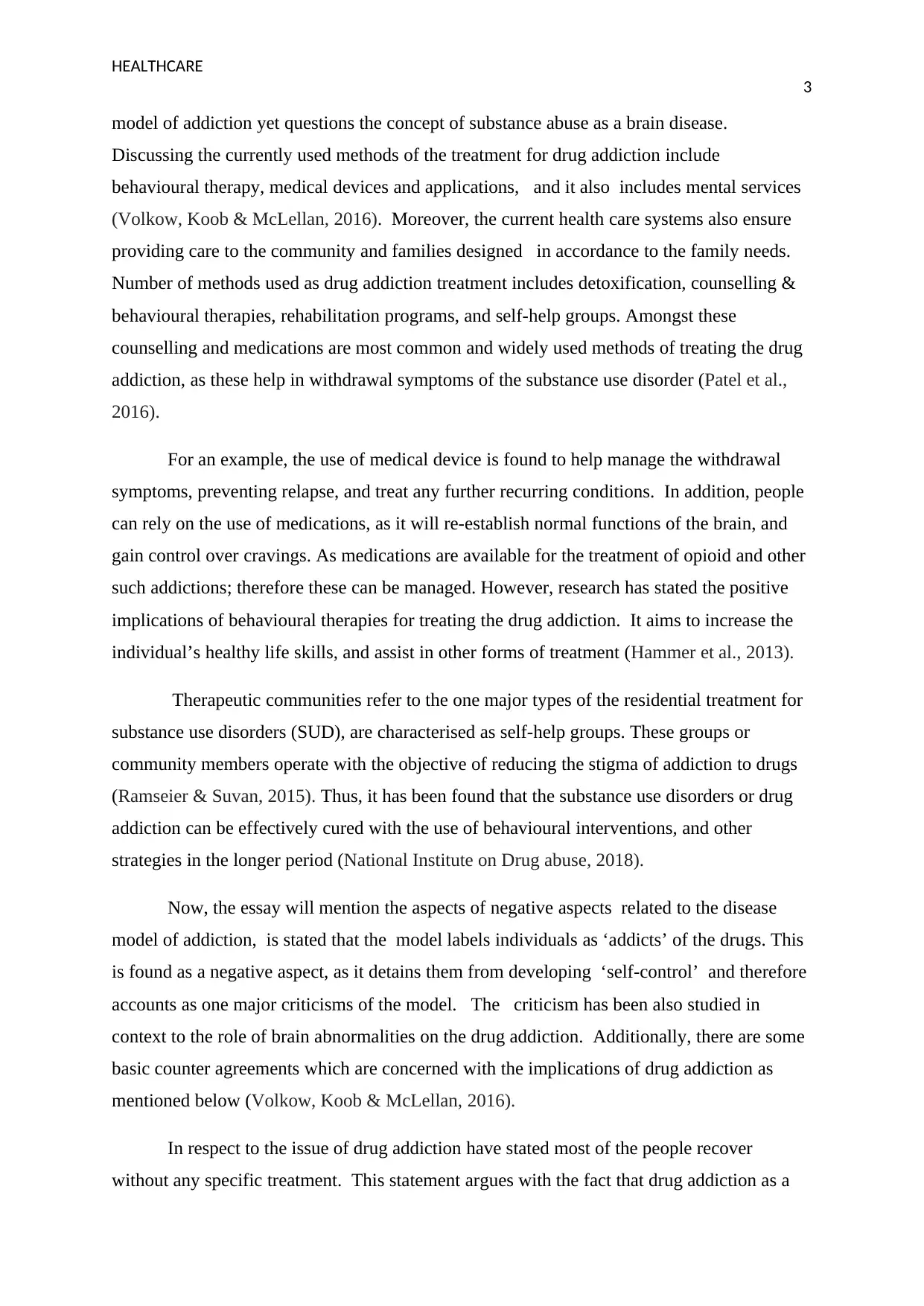
HEALTHCARE
3
model of addiction yet questions the concept of substance abuse as a brain disease.
Discussing the currently used methods of the treatment for drug addiction include
behavioural therapy, medical devices and applications, and it also includes mental services
(Volkow, Koob & McLellan, 2016). Moreover, the current health care systems also ensure
providing care to the community and families designed in accordance to the family needs.
Number of methods used as drug addiction treatment includes detoxification, counselling &
behavioural therapies, rehabilitation programs, and self-help groups. Amongst these
counselling and medications are most common and widely used methods of treating the drug
addiction, as these help in withdrawal symptoms of the substance use disorder (Patel et al.,
2016).
For an example, the use of medical device is found to help manage the withdrawal
symptoms, preventing relapse, and treat any further recurring conditions. In addition, people
can rely on the use of medications, as it will re-establish normal functions of the brain, and
gain control over cravings. As medications are available for the treatment of opioid and other
such addictions; therefore these can be managed. However, research has stated the positive
implications of behavioural therapies for treating the drug addiction. It aims to increase the
individual’s healthy life skills, and assist in other forms of treatment (Hammer et al., 2013).
Therapeutic communities refer to the one major types of the residential treatment for
substance use disorders (SUD), are characterised as self-help groups. These groups or
community members operate with the objective of reducing the stigma of addiction to drugs
(Ramseier & Suvan, 2015). Thus, it has been found that the substance use disorders or drug
addiction can be effectively cured with the use of behavioural interventions, and other
strategies in the longer period (National Institute on Drug abuse, 2018).
Now, the essay will mention the aspects of negative aspects related to the disease
model of addiction, is stated that the model labels individuals as ‘addicts’ of the drugs. This
is found as a negative aspect, as it detains them from developing ‘self-control’ and therefore
accounts as one major criticisms of the model. The criticism has been also studied in
context to the role of brain abnormalities on the drug addiction. Additionally, there are some
basic counter agreements which are concerned with the implications of drug addiction as
mentioned below (Volkow, Koob & McLellan, 2016).
In respect to the issue of drug addiction have stated most of the people recover
without any specific treatment. This statement argues with the fact that drug addiction as a
3
model of addiction yet questions the concept of substance abuse as a brain disease.
Discussing the currently used methods of the treatment for drug addiction include
behavioural therapy, medical devices and applications, and it also includes mental services
(Volkow, Koob & McLellan, 2016). Moreover, the current health care systems also ensure
providing care to the community and families designed in accordance to the family needs.
Number of methods used as drug addiction treatment includes detoxification, counselling &
behavioural therapies, rehabilitation programs, and self-help groups. Amongst these
counselling and medications are most common and widely used methods of treating the drug
addiction, as these help in withdrawal symptoms of the substance use disorder (Patel et al.,
2016).
For an example, the use of medical device is found to help manage the withdrawal
symptoms, preventing relapse, and treat any further recurring conditions. In addition, people
can rely on the use of medications, as it will re-establish normal functions of the brain, and
gain control over cravings. As medications are available for the treatment of opioid and other
such addictions; therefore these can be managed. However, research has stated the positive
implications of behavioural therapies for treating the drug addiction. It aims to increase the
individual’s healthy life skills, and assist in other forms of treatment (Hammer et al., 2013).
Therapeutic communities refer to the one major types of the residential treatment for
substance use disorders (SUD), are characterised as self-help groups. These groups or
community members operate with the objective of reducing the stigma of addiction to drugs
(Ramseier & Suvan, 2015). Thus, it has been found that the substance use disorders or drug
addiction can be effectively cured with the use of behavioural interventions, and other
strategies in the longer period (National Institute on Drug abuse, 2018).
Now, the essay will mention the aspects of negative aspects related to the disease
model of addiction, is stated that the model labels individuals as ‘addicts’ of the drugs. This
is found as a negative aspect, as it detains them from developing ‘self-control’ and therefore
accounts as one major criticisms of the model. The criticism has been also studied in
context to the role of brain abnormalities on the drug addiction. Additionally, there are some
basic counter agreements which are concerned with the implications of drug addiction as
mentioned below (Volkow, Koob & McLellan, 2016).
In respect to the issue of drug addiction have stated most of the people recover
without any specific treatment. This statement argues with the fact that drug addiction as a
Paraphrase This Document
Need a fresh take? Get an instant paraphrase of this document with our AI Paraphraser
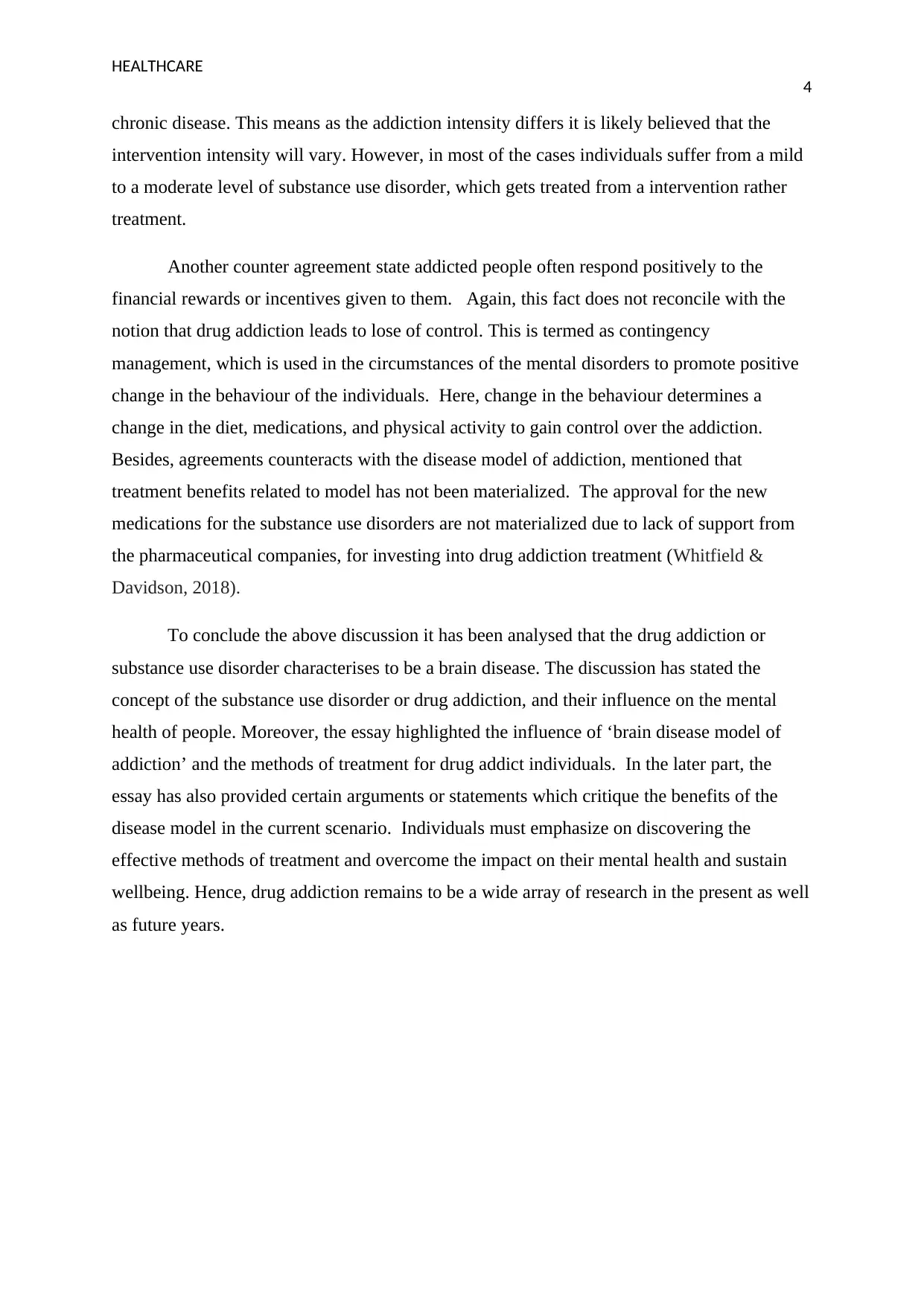
HEALTHCARE
4
chronic disease. This means as the addiction intensity differs it is likely believed that the
intervention intensity will vary. However, in most of the cases individuals suffer from a mild
to a moderate level of substance use disorder, which gets treated from a intervention rather
treatment.
Another counter agreement state addicted people often respond positively to the
financial rewards or incentives given to them. Again, this fact does not reconcile with the
notion that drug addiction leads to lose of control. This is termed as contingency
management, which is used in the circumstances of the mental disorders to promote positive
change in the behaviour of the individuals. Here, change in the behaviour determines a
change in the diet, medications, and physical activity to gain control over the addiction.
Besides, agreements counteracts with the disease model of addiction, mentioned that
treatment benefits related to model has not been materialized. The approval for the new
medications for the substance use disorders are not materialized due to lack of support from
the pharmaceutical companies, for investing into drug addiction treatment (Whitfield &
Davidson, 2018).
To conclude the above discussion it has been analysed that the drug addiction or
substance use disorder characterises to be a brain disease. The discussion has stated the
concept of the substance use disorder or drug addiction, and their influence on the mental
health of people. Moreover, the essay highlighted the influence of ‘brain disease model of
addiction’ and the methods of treatment for drug addict individuals. In the later part, the
essay has also provided certain arguments or statements which critique the benefits of the
disease model in the current scenario. Individuals must emphasize on discovering the
effective methods of treatment and overcome the impact on their mental health and sustain
wellbeing. Hence, drug addiction remains to be a wide array of research in the present as well
as future years.
4
chronic disease. This means as the addiction intensity differs it is likely believed that the
intervention intensity will vary. However, in most of the cases individuals suffer from a mild
to a moderate level of substance use disorder, which gets treated from a intervention rather
treatment.
Another counter agreement state addicted people often respond positively to the
financial rewards or incentives given to them. Again, this fact does not reconcile with the
notion that drug addiction leads to lose of control. This is termed as contingency
management, which is used in the circumstances of the mental disorders to promote positive
change in the behaviour of the individuals. Here, change in the behaviour determines a
change in the diet, medications, and physical activity to gain control over the addiction.
Besides, agreements counteracts with the disease model of addiction, mentioned that
treatment benefits related to model has not been materialized. The approval for the new
medications for the substance use disorders are not materialized due to lack of support from
the pharmaceutical companies, for investing into drug addiction treatment (Whitfield &
Davidson, 2018).
To conclude the above discussion it has been analysed that the drug addiction or
substance use disorder characterises to be a brain disease. The discussion has stated the
concept of the substance use disorder or drug addiction, and their influence on the mental
health of people. Moreover, the essay highlighted the influence of ‘brain disease model of
addiction’ and the methods of treatment for drug addict individuals. In the later part, the
essay has also provided certain arguments or statements which critique the benefits of the
disease model in the current scenario. Individuals must emphasize on discovering the
effective methods of treatment and overcome the impact on their mental health and sustain
wellbeing. Hence, drug addiction remains to be a wide array of research in the present as well
as future years.
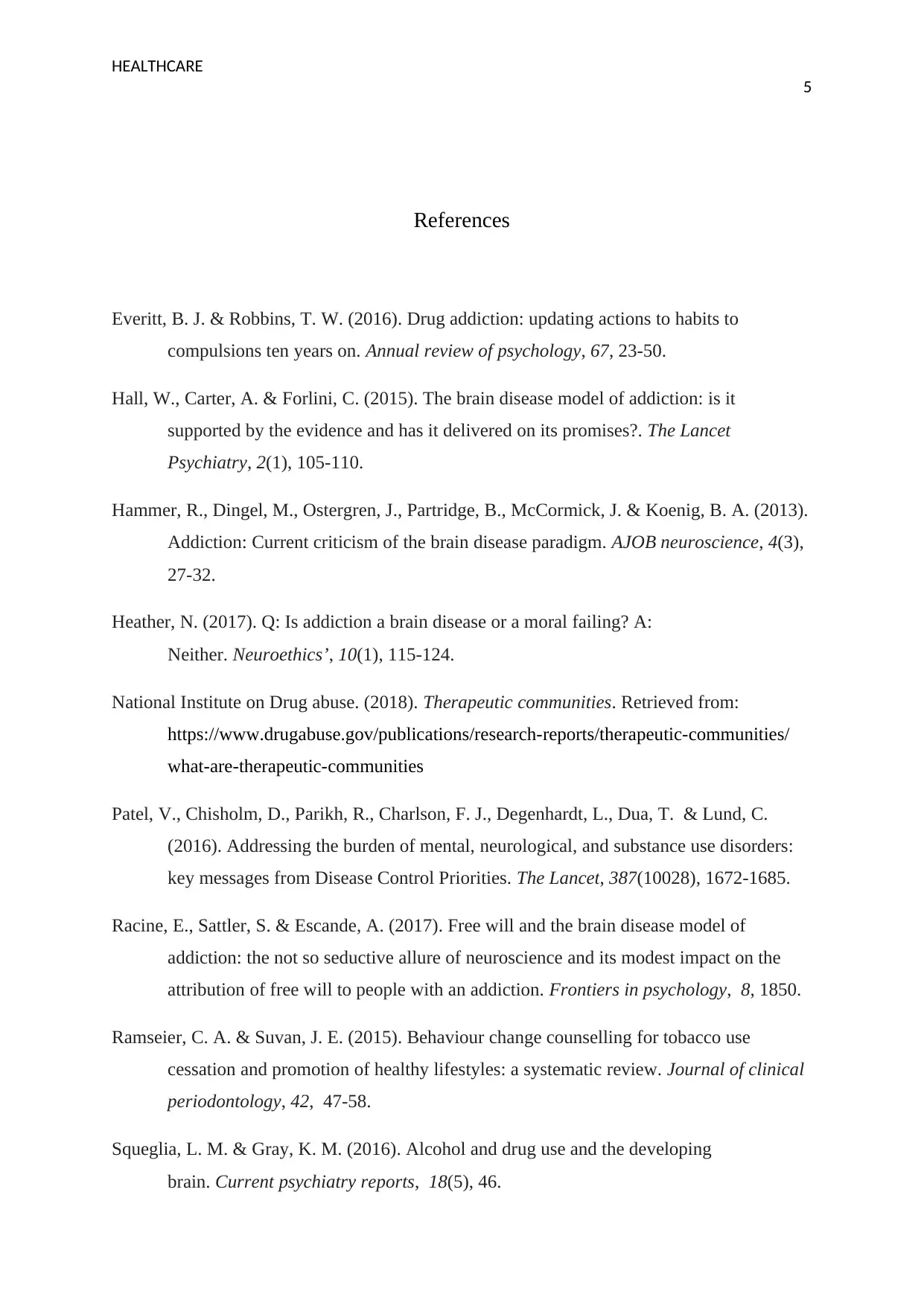
HEALTHCARE
5
References
Everitt, B. J. & Robbins, T. W. (2016). Drug addiction: updating actions to habits to
compulsions ten years on. Annual review of psychology, 67, 23-50.
Hall, W., Carter, A. & Forlini, C. (2015). The brain disease model of addiction: is it
supported by the evidence and has it delivered on its promises?. The Lancet
Psychiatry, 2(1), 105-110.
Hammer, R., Dingel, M., Ostergren, J., Partridge, B., McCormick, J. & Koenig, B. A. (2013).
Addiction: Current criticism of the brain disease paradigm. AJOB neuroscience, 4(3),
27-32.
Heather, N. (2017). Q: Is addiction a brain disease or a moral failing? A:
Neither. Neuroethics’, 10(1), 115-124.
National Institute on Drug abuse. (2018). Therapeutic communities. Retrieved from:
https://www.drugabuse.gov/publications/research-reports/therapeutic-communities/
what-are-therapeutic-communities
Patel, V., Chisholm, D., Parikh, R., Charlson, F. J., Degenhardt, L., Dua, T. & Lund, C.
(2016). Addressing the burden of mental, neurological, and substance use disorders:
key messages from Disease Control Priorities. The Lancet, 387(10028), 1672-1685.
Racine, E., Sattler, S. & Escande, A. (2017). Free will and the brain disease model of
addiction: the not so seductive allure of neuroscience and its modest impact on the
attribution of free will to people with an addiction. Frontiers in psychology, 8, 1850.
Ramseier, C. A. & Suvan, J. E. (2015). Behaviour change counselling for tobacco use
cessation and promotion of healthy lifestyles: a systematic review. Journal of clinical
periodontology, 42, 47-58.
Squeglia, L. M. & Gray, K. M. (2016). Alcohol and drug use and the developing
brain. Current psychiatry reports, 18(5), 46.
5
References
Everitt, B. J. & Robbins, T. W. (2016). Drug addiction: updating actions to habits to
compulsions ten years on. Annual review of psychology, 67, 23-50.
Hall, W., Carter, A. & Forlini, C. (2015). The brain disease model of addiction: is it
supported by the evidence and has it delivered on its promises?. The Lancet
Psychiatry, 2(1), 105-110.
Hammer, R., Dingel, M., Ostergren, J., Partridge, B., McCormick, J. & Koenig, B. A. (2013).
Addiction: Current criticism of the brain disease paradigm. AJOB neuroscience, 4(3),
27-32.
Heather, N. (2017). Q: Is addiction a brain disease or a moral failing? A:
Neither. Neuroethics’, 10(1), 115-124.
National Institute on Drug abuse. (2018). Therapeutic communities. Retrieved from:
https://www.drugabuse.gov/publications/research-reports/therapeutic-communities/
what-are-therapeutic-communities
Patel, V., Chisholm, D., Parikh, R., Charlson, F. J., Degenhardt, L., Dua, T. & Lund, C.
(2016). Addressing the burden of mental, neurological, and substance use disorders:
key messages from Disease Control Priorities. The Lancet, 387(10028), 1672-1685.
Racine, E., Sattler, S. & Escande, A. (2017). Free will and the brain disease model of
addiction: the not so seductive allure of neuroscience and its modest impact on the
attribution of free will to people with an addiction. Frontiers in psychology, 8, 1850.
Ramseier, C. A. & Suvan, J. E. (2015). Behaviour change counselling for tobacco use
cessation and promotion of healthy lifestyles: a systematic review. Journal of clinical
periodontology, 42, 47-58.
Squeglia, L. M. & Gray, K. M. (2016). Alcohol and drug use and the developing
brain. Current psychiatry reports, 18(5), 46.
⊘ This is a preview!⊘
Do you want full access?
Subscribe today to unlock all pages.

Trusted by 1+ million students worldwide
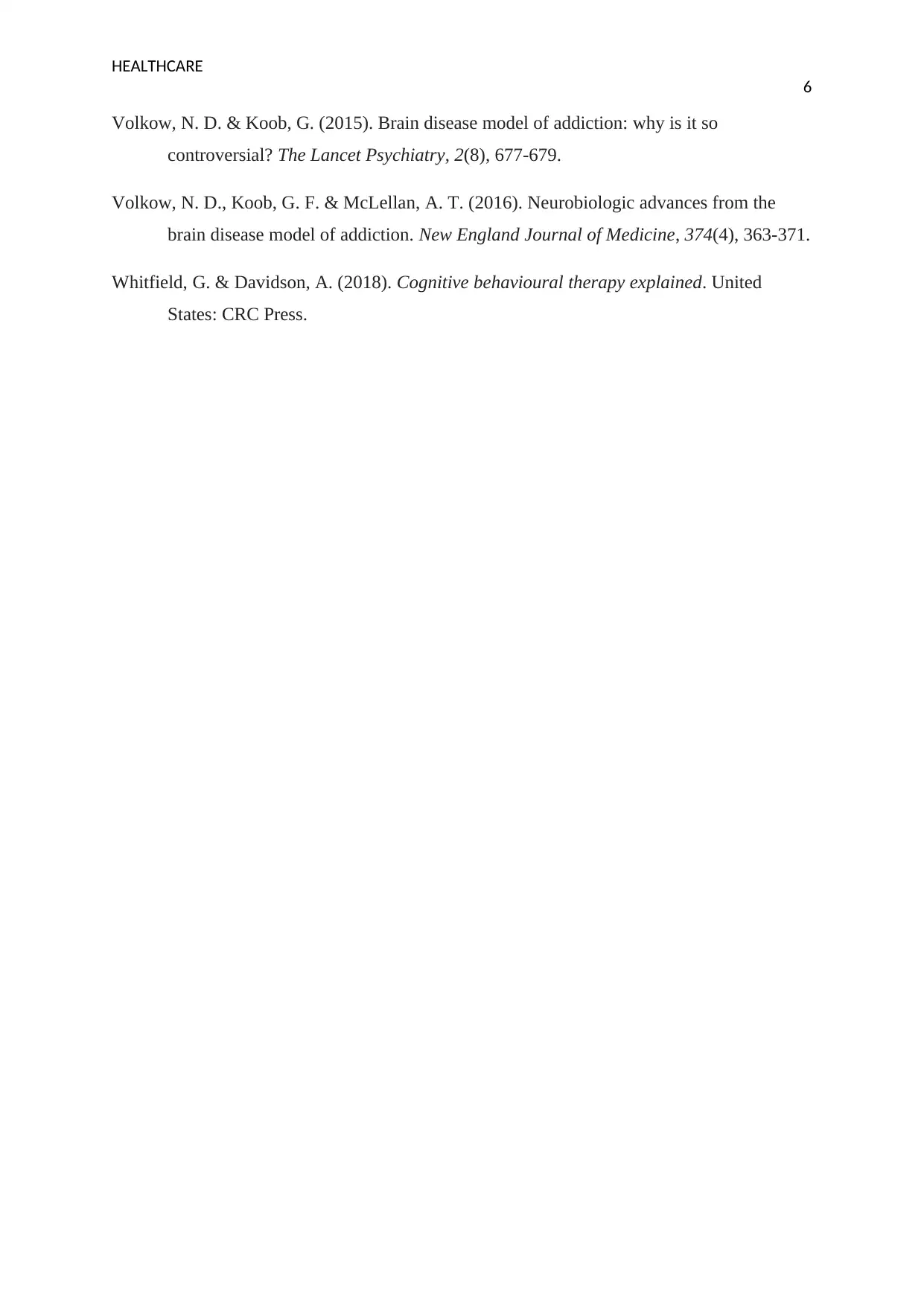
HEALTHCARE
6
Volkow, N. D. & Koob, G. (2015). Brain disease model of addiction: why is it so
controversial? The Lancet Psychiatry, 2(8), 677-679.
Volkow, N. D., Koob, G. F. & McLellan, A. T. (2016). Neurobiologic advances from the
brain disease model of addiction. New England Journal of Medicine, 374(4), 363-371.
Whitfield, G. & Davidson, A. (2018). Cognitive behavioural therapy explained. United
States: CRC Press.
6
Volkow, N. D. & Koob, G. (2015). Brain disease model of addiction: why is it so
controversial? The Lancet Psychiatry, 2(8), 677-679.
Volkow, N. D., Koob, G. F. & McLellan, A. T. (2016). Neurobiologic advances from the
brain disease model of addiction. New England Journal of Medicine, 374(4), 363-371.
Whitfield, G. & Davidson, A. (2018). Cognitive behavioural therapy explained. United
States: CRC Press.
1 out of 7
Related Documents
Your All-in-One AI-Powered Toolkit for Academic Success.
+13062052269
info@desklib.com
Available 24*7 on WhatsApp / Email
![[object Object]](/_next/static/media/star-bottom.7253800d.svg)
Unlock your academic potential
Copyright © 2020–2025 A2Z Services. All Rights Reserved. Developed and managed by ZUCOL.




